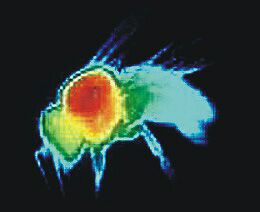Observing and recording the defence strategies
of giant honeybees (Apis dorsata)
G.K. Kastberger, O. Winder and K. Steindl
Zoology, University of Graz, Graz, Austria

Figure 1.
Aggregation
of giant honeybee nests.
This film focuses on
the social structure of the South Asian Giant Honeybee Apis dorsata (Figure
1), and demonstrates that the bees' ferocity reflects their potent defence capacity.
With a unique set of defence strategies, this bee is adapted to cope with many
predators. The film explains how thousands of individuals within a bee community
can cooperate to defend themselves against predators. The whole repertoire of
a colony's defence strategies is displayed, in the context of natural predation
and under controlled experimental conditions. The following behavioral aspects
are shown, as visualised by infrared camera (Figure 2):
- Wasps are prevented from effectively fixing their eyes on individual bees
by wave patterns, which involve thousands of bees in the outermost layer of
the 'bee curtain'. This process is pheromonally linked, via Nasonov scenting
[1].
- When a wasp comes into contact with a nest, the worker bees form a ball
around it and increase the temperature until the wasp dies.
- Larger predators cause the colony to produce massive waves, with all bees
stretching their bodies upward, activating their flight muscles and acoustically
mimicking feral mammals. This causes the nest to thicken and enlarge.
- Thousands of bees can counterattack birds and humans in a split second.
This is illustrated using bee-eaters, which have a unique hunting strategy
[2].
- Colonies that are not directly threatened can participate in the defence
response of those that are.
- Only colonies able to respond rapidly are prepared for mass defence. Infrared
recording demonstrates how an undisturbed colony mobilises its defence strategies.
If disturbed, nest-warm bees emerge from deeper layers to the nest surface
within one minute (Figure 3); these are referred to as 'soldier bees'. A single
disturbing stimulus is sufficient to make these bees attack.
- Colonies can memorize previous disturbances and keep soldier bees on 'stand-by'.
While the mobilisation of mass defence can be observed directly, the readiness
of a colony to attack cannot be assessed without knowledge of its past history.

Figure 2.
Infrared
image of a giant honeybee (25-37oC).

Figure 3.
Stimulation
experiment.
Acknowledgments: Grant 13210 of the Austrian Scientific Foundation; infrared camera sponsored by NBN Electronics Graz; epo-film Wien-Graz, Austria.
References
- Kastberger, G. et al. (1998). Ethology, 104, 27.
- Kastberger, G.; Sharma, D.K. (2000). Apidologie, 31, 727.
Paper presented at Measuring Behavior 2002
, 4th International Conference on Methods and Techniques in Behavioral
Research, 27-30 August 2002, Amsterdam, The Netherlands
© 2002
Noldus Information Technology bv



